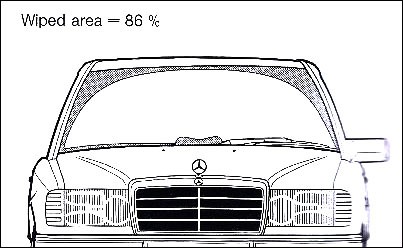For those with an appreciation for automotive ingenuity, spotting a Mercedes-Benz equipped with a monoblade wiper is like finding a hidden gem. There’s a certain fascination in watching this single wiper arm gracefully sweep across the windshield, a distinctive feature that sets older Mercedes models apart. But the Mercedes-Benz monoblade wiper is more than just a quirky design choice; it’s a testament to innovative engineering aimed at optimizing performance and efficiency. Let’s delve into what makes this “eccentric clean sweep” system so unique and why it remains a memorable feature for Mercedes-Benz enthusiasts.
While single blade wipers weren’t new when Mercedes introduced their Monoblade system, the approach they took was truly distinctive. Unlike conventional single wipers found on various cars, from budget-friendly Fiats to sporty Sciroccos, the Mercedes-Benz wiper was engineered for enhanced windshield coverage. The secret lies in its sophisticated hub mechanism, designed to maximize the wiped area far beyond a simple arc motion.
As depicted in the diagram illustrating the “single arm (controlled)” motion, the Monoblade achieves its impressive coverage by extending outwards towards the corners of the windshield during its sweep. This is accomplished by a cam-type device within the hub that cleverly moves the arm away from the pivot point twice per cycle. This extension and retraction choreography ensures comprehensive cleaning without overreaching at the top of the windshield. Observing the Monoblade in action is akin to witnessing a meticulously choreographed mechanical ballet – a fluid and almost mesmerizing display of engineering. It’s this unique motion that captivates observers and makes the Mercedes-Benz wiper system so memorable.
Introduced on models like the W201 190E, and later featured in the W124 and W210 E-Class generations, as well as the W202 C-Class, the Monoblade system offered tangible benefits. Its primary advantage was aerodynamic efficiency, demonstrably reducing wind resistance at high speeds, a significant factor for vehicles designed for the Autobahn. Despite its seemingly simpler single-arm design compared to traditional dual-wiper systems, the Monoblade was actually more complex and costly to manufacture and repair due to its specialized components. Furthermore, owners sometimes faced challenges in sourcing the uniquely long wiper blades required for replacement. Another minor drawback was a subtle rocking motion that could be felt within the car when the wiper operated at high speed, a slight compromise in the otherwise luxurious Mercedes-Benz experience.
Despite these minor disadvantages, the Mercedes-Benz monoblade wiper remains a celebrated example of automotive innovation. It’s a feature that embodies the brand’s commitment to engineering excellence, even in seemingly mundane components like windshield wipers. So, the next time you see an older Mercedes-Benz in the rain, take a moment to appreciate the distinctive dance of its monoblade wiper – a small but significant detail that speaks volumes about Mercedes-Benz’s dedication to unique and effective engineering solutions for their vehicles. When it comes to Wiper For Mercedes Benz, the monoblade system is definitely a standout.

